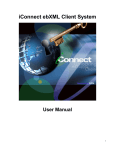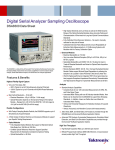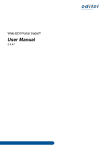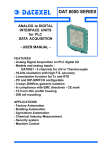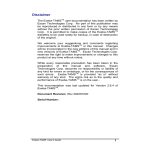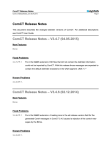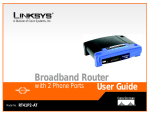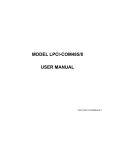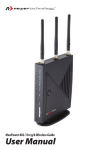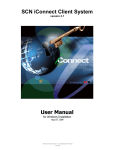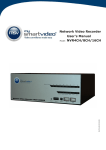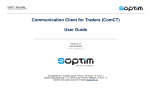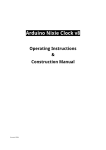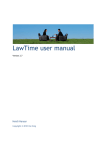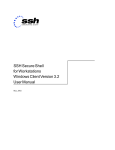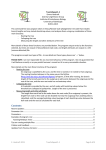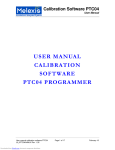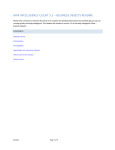Download iConnect Client System
Transcript
iConnect Client System User Manual 1 TABLE OF CONTENTS I. INSTALLATION SETUP GUIDE I.A System Requirements 3 I.B Installing and Running the iConnect Client System 3 I.C Setting Up Your Company’s Identity (Generating Key Pairs) 5 I.D Configuring the Display Style Sheet and Internet Browser Application 11 I.E Setting the iConnect Server URL 13 I.F. Schema File Configurations 14 I.G Uninstalling iConnect Client System 15 II. USING iCONNECT CLIENT SYSTEM II.A Sending and Receiving Messages 16 II.B. Mapping Configurations 22 II.C. Viewing Message in HTML or XML 25 II.D. Creating Folders 26 II.E. Renaming Folders 28 II.F. Deleting Folders 30 II.G. Moving Messages 31 II.H. Deleting Messages 32 II.I. Emptying Trash 34 II.J. Checking iConnect Version 35 II.K. Adding New Contacts and Specifying Contact Display Style Sheets 36 II.L. Editing Contacts 38 II.M. Deleting Contacts 38 II.N. Sorting Messages 39 II.O. Finding Messages 39 II.P. Schedule Manager 40 II.Q. Log Viewer 53 II.R. Setting Proxy Server 58 II.S. Java Heap Size Settings 59 III. TIPS ON PREVENTING SENDING OF DUPLICATE MESSAGES III.A Manual Operation of iConnect Import and Send Operations 61 III.B. Automated Import and Send Operation (Scheduler) 61 2 I. INSTALLATION SETUP GUIDE I.A. System Requirements 1. Pentium III 500Mhz or higher or equivalent CPU. At least 128 MB RAM memory is required. 2. Operating System: Any Operating System that supports Java Runtime Environment (JRE) 1.4.1 or higher. Sample operating systems supported are: • • • • • • Windows 95, 98, ME Windows NT 4.0 service pack 5 Windows 2000 Windows XP Linux Intel kernel v2.2.12 Solaris 3. Minimum screen area setting is 800 x 600 pixels. Recommended value is 1024 x 768 for better viewing of the interface. I.B. Installing & Running the IConnect Client System 1. Install the Java Runtime Environment using the JRE installer included in the zip file or downloaded from http://java.sun.com/downloads.html. To check whether the JRE is installed in the system, run "java -version" on the command-line prompt. If JRE is properly installed, you should see the following output at the screen: C:\>java -version java version "1.4.1_03" Java(TM) 2 Runtime Environment, Standard Edition (build 1.4.1_03-b02) Java HotSpot(TM) Client VM (build 1.4.1_03-b02, mixed mode) 3 2. Extract the iConnect zip file to a specified directory location. This extraction will create the iconnect folder which contains the needed files to run the application. For example, extracting the zip file to C:\ will create iconnect folder in that directory. 3. Run the iConnect Client App: a) Windows Explorer Go to the iconnect folder and double-click iconnect_run.bat file. b) Command Line Go to the iconnect folder, type iconnect_run.bat and then press Enter. c) To run iconnect on Linux, use this command inside the iconnect folder: $ sh ./ iconnect_run.sh Note: Make sure that the file's executable permission is set correctly. You can issue this command to make the script file executable to all users: chmod 777 iconnect_run.sh 4 4. After launching iConnect, the application will check if the JRE's security file is updated. iConnect will automatically update JRE's security settings that will be used during runtime. A message will be prompted that the security settings was updated. Just restart the application after it shutdowns. I.C. Setting Up Your Company’s Identity (Generating Key Pairs) Public and Private keys generated by your iConnect client application will be used to identify your client PC when accessing the message service of the iConnect Server. Please follow these steps to generate the key pairs: 1. Go to Settings > Security & Identity at the menu options to launch the Security & Identity Configurations window. 2. Below is the Security & Identity Configurations window. Click the Identity tab to view the Identity settings. 5 Global Location Number (GLN) – a 13-digit number used to uniquely identify a location. • Specify the Global Location Number or GLN of your company to set the Local Party ID to be used by the application. Local Party ID – identification name that will be registered to the iConnect server. It consists of the URL prefix http://www.panc.org.ph/party/GLNnumber • By default, the prefix of the Local Party ID is http://www.panc.org.ph/party/. Click the Edit Prefix button if you want to replace the prefix specified. Company Name – Specify the company name. 3. Click the Security tab to view the Security settings. 6 Private Key (Secret Key) – contains the secret key file that will be used to identify the client user to the iConnect server. Public Key – contains the public key file to be submitted for authentication. Public Key Certificate – contains the certificate file which is issued after authenticating the public key file. Passphrase – private key password 4. Click the Generate New Key Pair button. 5. After clicking the Generate New Key pair button this warning message will appear. 7 6. Click OK to launch the Generate New Key Pair dialog box. Fill-up the following fields: New Passphrase – password for the Public and Private Key and for login access in the iConnect client application. Export Private Key As – filename of the Private Key to be generated. Note that the extension name .sk will be automatically added at the end of the filename you specify. The Private Key file will be saved inside the iconnect application folder. Export Public Key As – filename of the Public key to be generated. Note that the extension name .pk will be automatically added at the end of the filename you specify. The Public key file will be saved inside the iconnect application folder. Use file naming scheme to distinguish different key pair versions Ex. Public key = My Company01.pk, My Company02.pk Secret key = My Company01.sk, My Company02.sk 7. Click Generate button to generate the key pairs. This will take some minutes to finish depending on the speed of your computer. 8 8. After the key pairs are generated, a message box will appear specifying the location where the generated key pair was saved. Click OK. 9. Click the Save button at the Security & Identity Configurations window to set your identity. It is important that you keep the Private Key (key pair with the .sk extension name) file from getting deleted or used by unauthorized persons. We recommend that you backup this file and take note of its passphrase. You can store the file in an access-secured directory or in a diskette. Just click the Browse button at the Security & Identity settings to specify the location of the Private/Secret key if you want to use it from a diskette of another folder. The Public Key (key pair with the .pk extension name) file must be submitted to the iConnect System Administrator for authentication, otherwise the client application will not be able to access the iConnect server. Send an email to [email protected] with the attached Public Key file and specify the following needed information in the email content: CN (Common Name) = Local Party ID used in generating the Public and Private keys OU (Organizational Unit) = Type of Organization Unit (ex. Food Manufacturing) O (Organization) = Name of Organization / Company L (Locality) = City ST (State) = State/Province C (Country) = Two-Letter Country Code 9 Here’s an example Public Key application info assuming that the http://www.panc.org.ph/party/1234567890999 (GLN is 1234567890999): CN OU O L ST C = = = = = = Local Party ID is http://www.panc.org.ph/party/1234567890999 Food Manufacturing My Company Quezon City Metro Manila PH The iConnect System Administrator will notify you as soon as the Public Key is authenticated. Note: There is no need to click the Generate new Key Pair button when your Public Key is already authenticated by the iConnect System Administrator. All you have to do is simply import your private key, public key and public key certificate, set its valid passphrase at the Security tab. To import the files, click Import button and specify the location of the needed file. After setting all the required files and passphrase, click the SAVE button. This will check whether all entries are correct, otherwise an error prompt will be shown. 10. When you restart the application again, you will be prompted to enter the passphrase for your Private Key file when the Require Passphrase at Login is checked at the Security tab in the Security and Identity Configurations window. 10 11. Below is the iConnect Login window. Enter the valid Passphrase to login. I.D. Configuring the Display Style Sheets and Internet browser application Display Style sheets are used to format the XML message for HTML view using the Internet Browser. Follow these steps to set the preferred display style sheets for each document type. 1. Go to Settings > Document Display to launch the Document Display Configuration window. 2. By clicking the Browse button, set the location of the Internet browser application that will be used for viewing the XML messages in HTML format (e.g. Internet Explorer or Netscape for Windows, Konqueror or Mozilla for Linux). 11 3. Set the Display Style sheet file for a particular document type by double-clicking the table row to launch the Set Display XSL File dialog window. The default values are already set for installed document types. 4. Click SAVE button. 12 I.E. Setting the iConnect Server URL 1. Go to Settings > Connections to specify the URL location of iConnect server. The default value is https://www.iconnect.com.ph. Note: See Section II.R. on how to configure the settings on Proxy Server Access. 13 I.F. Schema File Configurations 1. Go to Settings > Document Schema to launch the window for viewing/importing the schema files that will be used to define the document type messages in the iConnect system. 2. By default there will be Document Types already installed in the system. You can find the schema files for these document types by referring to the Location column. 14 3. To create new document type, click on the Import New Schema button to launch the dialog window for importing the new schema file. 4. Fill up the following text fields and then click the Import button to create the new document type based on the schema file: Document Type – name of the message document. ex. PO, PRODAT Description – description for the message document. ex. PURCHASE ORDER, PRODUCT DATA Location – file location of the schema file; click the Browse button to set the schema file's location I.G. Uninstalling iConnect Client System To uninstall the application, simply delete the iconnect folder. 15 II. USING iCONNECT CLIENT SYSTEM II.A. Sending and Receiving Messages To test the iConnect Client System use the sample PO (purchase order) CSV files provided during installation found in iconnect_v2/sample/po directory. Sending PO Messages 1. Before importing the sample CSV files, set first the BUYER and SELLER GLN columns in the CSV file. Replace the text SET_SENDER_GLN_HERE with the buyer/sender GLN and SET_RECEPIENT_GLN_HERE with the seller/receiver GLN. 2. Go to File > Import or simply click IMPORT button to launch the Import CSV file to XML message window. 16 3. Specify the document type of the CSV file to be imported. Click the BROWSE button to specify the location of the CSV file then click OK to import it. During import, a progress window will be shown. After successfully importing the CSV file you should see this info message window. This will create PO XML messages in OUTBOX folder. 4. Check your OUTBOX folder. There should be 5 messages in it. 5. Go to Action > Send Message or simply click SEND button to send PO XML messages from OUTBOX folder to iConnect server. All messages successfully sent will be archived in the SENT folder. 17 Receiving Acknowledgement from iConnect Server 1. Go to Action > Receive Message or simply click Receive button to retrieve Acknowledgement messages from server. 18 2. All Acknowledgement messages will be placed in the ACKNOWLEDGEMENT folder. These messages serve as a confirmation that the PO XML messages are now routed in the recipient’s inbox at the server. If you are able to receive the acknowledgement messages properly, your private key and public keys are properly set and your connection to the iConnect server is working. Receiving XML Message 1. Go to Action > Receive Message or simply click Receive button to retrieve XML messages from the server. All XML messages will be placed in the INBOX folder. 19 2. Export the XML messages as either CSV or XML file by selecting first the message(s) and by doing the following: a) Go to File > Export b) Click the EXPORT button 20 c) Right-click on the selected message(s) to be exported and choose Export As… 3. The Export XML to CSV/XML File dialog will be shown. Selected messages can be exported either in CSV or XML file format. Click the BROWSE button to specify the target directory. Click OK to start exporting the selected files. 21 II.B. Mapping Configurations Default mapping configurations for the pre-installed document types are already specified for your convenience. You can use these mapping configurations to import the sample CSV file inside the iconnect/sample/ directory in the iconnect folder. Reference for the mapping configurations for this CSV file is also located in the same directory. To set iConnect on how to import CSV files to XML message and export XML message to the preferred CSV format, specify the appropriate mapping columns for each document type. 1. Go to Settings > Mapper. There are 2 options for this item: a) Import Configurations - for setting the Import mapping configurations (CSV to XML message). . b) Export Configurations - for setting the Export mapping configurations (XML message to CSV). 22 2. In the mapping configuration window, choose the document type for specifying the column numbers for each element/attribute of the XML message. a) For Import Configurations, specify the column number where the XML element/attribute is located in the CSV file. You can leave the column number blank for optional elements/attributes so that these data will not be included in generated XML message. Be careful in specifying the column values to avoid parsing errors during import of CSV files. Duplicate column value entries are not allowed, except for the Receiver's Party ID, which is the GLN location of the receiver of your XML message document. b) For Export mapping configurations, specify the column number where the XML element/attribute from the XML message will be placed in the generated CSV file. Take note that empty field entries are not allowed and column values should be sequential. 23 c) documentID parameter should be set always to 1. d) Click the Save button to save the settings. 24 II.C. View Message in HTML or XML 1. View message in HTML by: a) Select a message. b) Go to View > Message > in HTML at the menu option, or c) Right click at the selected message and select View Document > in HTML. 2. View message in XML by: a) Select a message. b) Go to View > Message > in XML at the menu option, or 25 c) Right click at the selected message and select View Document > in XML. Note: Only one message at a time can be viewed in HTML/XML. Note: Newly received messages are in bold fonts. Once viewed in either HTML or XML the Read status box will be checked and will change its font from bold to regular. Note: At the lower left of iConnect Client System window, is the folder/message status indicator. Clicking at a particular folder tells you the number of new messages and the total number of messages in that folder. II.D. Creating Folders iConnect Client System has 7 default folders found in the folders view pane: 26 Folders - contains the other default folders. INBOX – contains all messages received from the server (except for document type: Acknowledment messages that are placed in the Acknowledgment folder). OUTBOX – contains messages successfully imported and for sending. SENT – contains sent messages.. ACKNOWLEDGMENT – contains acknowledgment messages. Acknowledgment messages signifies a confirmation that the message(s) sent was successfully delivered to the inbox of the recipient. DRAFT – contains draft messages. Only messages from the OUTBOX folder can be placed/move here. TRASH – contains all deleted messages. Note: Default folders cannot be deleted or renamed. 1. Create folders by: a) Select a folder. b) Go to File > New> Folder at the menu option or 27 c) Right click at the selected folder or anywhere in the folders view pane and select New. d) Enter the name of your folder you want to create and click OK. II.E. Renaming Folders 1. Rename folders by: a) Select a folder. 28 b) Go to Edit > Folder > Rename at the menu option or c) Right click at the selected folder or anywhere in the folders view pane and select Rename. d) Enter the new name of your folder and click OK. II.F. Deleting Folders 1. Delete folders by: 29 a) Select a folder. b) Go to Edit > Folder > Delete at the menu option, or c) Right click at the selected folder or anywhere in the folders view pane and select Delete. 30 d) Click Yes to delete the folder. II.G. Moving Messages 1. Move message(s) by: a) Select message(s) to move. b) Go to Edit > Message > Move at the menu option or 31 c) Right click at the selected message(s) and select Move. d) Click the folder where you want to move your message(s) and click OK. II.H. Deleting Messages 1. Delete message(s) by: a) Select message(s) to delete. 32 b) Go to Edit > Message > Delete at the menu option or c) Right click at the selected message(s) and select Delete. d) Click Yes to delete the message(s). Tip!: If you notice that your iConnect Client System is slowing down particularly in loading messages when clicking in folders, segregate the messages in that folder by creating subfolders and move other messages to the subfolder. 33 Tip: For optimum performance on loading messages in folders, limit the maximum number of messages between 500 to 1000 entries. II.I. Emptying and Recovering Message From Trash 1. Empty Trash by: a) Click TRASH Folder. b) Go to Action > Empty Trash at the menu option, or 34 c) Right click at the TRASH folder or anywhere at the Folders window pane and select Empty trash. Note: iConnect allows to restore messages once deleted by moving it to your desired folder. However you cannot move messages from TRASH folder to either OUTBOX or DRAFT folders. Tip: It is recommended that the TRASH folder should be emptied on a regular basis. Limit the number of deleted messages in the TRASH folder between 500 to 1000 for optimum performance when loading and emptying the TRASH folder. II.J. Checking iConnect Version 1. Go to Help > About iConnect menu option 2. Below is the About iConnect dialog window. It serves as a quick reference for your iConnect System information which will be useful for technical support. 35 II.K. Adding New Contacts and Specifying Contact Display Style Sheets You can add contacts containing company information such as Name and Party ID. Contacts are useful to easily identify the sender or receiver of your messages in the message grid view. You can also specify specific display style sheets for each contact. 1. Add a contact list by: a) Right-click at the Contact List window pane. Choose New to launch the Create New Contact Information window, or b) Go to File > New > Contact... at the menu option: 36 2. Fill-up the text fields and then click the Save button when finished. Note: Name and Party ID are required values. 3. At the bottom of the Contact Information window, you will see a grid table where you can specify display style sheet for a particular contact. Double-click on the File Location’s row to launch the Set File dialog window. Choose the display style sheet file of the contact. 4. Click the Save button to save all settings. 37 II.L. Editing Contacts 1. Edit a contact list by: a) Go to Edit> Contacts > Edit/View... at the menu option, or b) Right-click at the Contact List window pane. Choose Edit/View to launch the Create New Contact Information window. II.M. Deleting Contacts 1. Delete a contact by: a) Go to Edit> Contacts > Delete... at the menu option, or 38 b) Right-click at the Contact List window pane. Choose Delete to launch the Create New Contact Information window. II. N. Sorting Messages IConnect can sort messages either in ascending or descending order according to column, by clicking at the table grid columns. Table Grid Columns II. O. Finding Messages Find Message lets users to locate a message with the specified Message ID value. 1. Go to Action > Find Message to use this tool. 39 2. Enter the Message ID you want to find and press ENTER or click the Find button. 3. Click the item in the list box to automatically point to the folder at the Folder Tree Viewer and to the message at the Message Table Viewer. II.P. Schedule Manager The iConnect Schedule Manager lets users automate the 4 basic tasks of the client system: (1) Import CSV files to generate the XML messages, (2) Send XML messages to the iConnect server, (3) Receive XML messages from the iConnect server, and (4) Export XML messages to CSV or XML files. To automate any of the 4 basic tasks, users must specify schedule entries in the Scheduler Manager. During the automated run of the specified tasks, logs will be prompted on the log viewer (See Section – on How to use logs). Users can do other operations like viewing a message in HTML or XML while the Scheduler Service is running. To set the Scheduler settings, go to Settings > Schedule Manager to launch the Schedule Manager window. 40 Below is a brief description of the controls you will see in the Schedule Manager. 41 The following diagram shows the Basic Schedule Controls in the Schedule Control View that can be used for setting the schedule for each task. 42 The following diagrams describe the Specific Controls for Import/Export and Send/Receive. These controls can be found below the Basic Schedule Controls in the Schedule Control View. How To Define Schedules in the Schedule Manager There are 5 parameters that should be specified when defining a schedule in the Schedule Manager: 1. Schedule Task Option – parameter for specifying if the task will be scheduled for automated run. Time – parameter for time entry values specified in the Set Time Per Time or Set Time By Range 2. option. 3. Day – parameter for containing which day of the week the task will be executed. Week Frequency – parameter for per week frequency, i.e. if the task will be executed every week, 4. every 3 weeks, etc. 5. Start Date – parameter for specifying the start date of task execution. 43 Here’s an example on how to set schedules using the Basic Schedule Controls: Example 1: Task for Scheduling = Import File to XML Message Time = 9:00 AM, 12:15 PM & 5:59 PM Day = Every Weekdays Week Frequency = Every Week Start On = Today (Jan 22, 2003) 44 45 If the current OS date/time is Jan 22, 2003 WED 4:30PM, the Scheduler Service will execute the task on the next latest schedule which is Jan 22, 2003 WED 5:59PM. The table below shows the 1-week schedule that will be generated after saving the settings on Jan 22, 2003 WED 4:30PM: DATE JAN 22, 2003 WED JAN 23, 2003 THURS JAN 24, 2003 FRI JAN 27, 2003 MON JAN 28, 2003 TUES TIME 5:59 PM 9:00 AM 12:15PM 5:59 PM 9:00 AM 12:15 PM 5:59 PM 9:00 AM 12:15 PM 5:59 PM 9:00 AM 12:15 PM 5:59 PM 46 Example 2: Task for Scheduling = Send XML Message to Server Time = 9:30 AM to 11:00 PM / Every 3 Hours Day = Every Tuesday, Thursday and Sunday Week Frequency = Every 2 Weeks Start On = Today (Feb 14, 2003) 47 If the current OS date/time is Jan 22, 2003 WED 4:30PM, the Scheduler Service will execute the task on the next latest schedule which is Feb 16, 2003 SUN 9:30AM (Feb 14, 2003 is not the next latest schedule because this date falls on Friday). The table below shows the 5-week schedule that will be generated after saving the settings on Jan 22, 2003 WED 4:30PM: WEEK DATE TIME 9:30 AM 12:30 PM 3:30 PM 6:30 PM 9:30 PM 9:30 AM 12:30 PM 3:30 PM 6:30 PM 9:30 PM 9:30 AM 12:30 PM 3:30 PM 6:30 PM 9:30 PM FEB 16, 2003 SUN 1st FEB 18, 2003 TUES FEB 20, 2003 THURS 2nd 3rd 4th 5th No Schedule MAR 2, 2003 SUN MAR 4, 2003 TUES MAR 6, 2003 THURS No Schedule MAR 16, 2003 SUN MAR 18, 2003 TUES MAR 20, 2003 THURS (same time) (same time) (same time) (same time) (same time) (same time) Note: Week starts on Sunday 48 How To Use the Import/Export Directory Bin To use the Import and Export task scheduler, users must set the Directory Bin folder location wherein the CSV/XML files will be placed for import or export. To set the Directory Bin location, set the Location of File parameter at the Specific Control for Import/Export Tasks (please refer to the Overview discussion). The Directory Bin consists of subfolders inside the specified Directory Bin location. Let’s say that the user specified C:\For Import folder as the Import task’s directory bin and C:\Exported folder as the Export Task’s directory bin. Assuming that we have 3 document types namely; PO, PRICAT and PRODAT, the following directory bin structure will be created after saving the scheduler settings: The Errors and Imported folders are automatically generated by the Schedule Manager. The Schedule Manager will create the Document Type (PO, PRICAT and PRODAT) Folders based on the imported 49 schema file document type name. If a schema file for a new document/message type is imported in the Schema Path Configuration, a new folder for this document type will be created in the Directory Bin for Import Task (assuming that the Import Task is set for scheduling). For example, if a new document type named RETURN was imported in the Schema Path Configuration and the Import task is set for scheduling, a RETURN document type folder will be created automatically in the C:\For Import directory bin. All RETURN CSV files must be placed in the RETURN document type folder for automatic import by the Scheduler Service. For Export Task, the directory bin will consist only of document type subfolders. All messages that are exported will be placed in the appropriate document type folder. If a message was not successfully exported, the message status will not change to EXPORTED at the Message View window. Below is a sample view of the directory structure for Export Task: 50 Starting/Stopping the Scheduler Service After saving all the settings for each task, click on the Start button to activate the Scheduler Service. The Scheduler Service can also be started by clicking Action > Start/Stop Scheduler Service menu item: When the Scheduler Service is successfully started, the status message at the lower right corner of the main iConnect window will change from Scheduler Service is OFF to Scheduler Service is ON. 51 Starting the Scheduler Service when iConnect starts To start the Scheduler Service after launching the iConnect Client app, check the Run Scheduler Service on iConnect Startup checkbox and then lick Save Settings button. The next time iConnect starts up, the Scheduler Service will automatically run. 52 II.Q. Log Viewer To help keep track of the messages being transacted, logging function has been implemented for this version of the IConnect Client System. The logs will note every activity the program is doing. Logging functions will also aid in troubleshooting the program in the event an error may occur. 1. Running Log Viewer. There are two ways to run the program. a) The Log Viewer can be launched without running iConnect Client System. At the iconnect directory double click log_viewer.bat (log_viewer.sh for Linux users) 53 b) If the iConnect Client System is already running, Log Viewer can be launched by clicking on View > Logs menu. 2. Views of Log Viewer. Go to View menu option. There are two views in Log Viewer. a) View Log Files - gives access to all log files created by iConnect Client System. This is the default view when launching Log Viewer without the iConnect Client System. Take note that Log File Viewer only open log files with a valid filename so refrain from renaming these files to avoid inconveniences. 54 The top left panel shows a list of folders located in the logs folder. Only folders labeled in YEAR_MONTH format will be displayed. Click on the folder you wish to show its content. Log files in the selected folder will be listed at the lower left panel. To open a log file, click on the file you wish to be displayed. The content of the log file will be shown on the main panel. You may cancel opening the log file by clicking on the cancel button which appears every time you open a log file. b) View Realtime Logging - shows the logs of the current process being done by iConnect Client System. This is the default view when launching LogViewer within the iConnect Client System. 55 The number of lines that can be displayed at a time and the filtering level can be set by accessing the Options > Realtime Log options or clicking on the Option button. Below is the Realtime Log Viewer Option window. Scrollback lines - Sets the allowable lines to be displayed for the View Realtime Logging. Realtime Log Filter - Sets the Level of logs to limit. This means that chosen level and higher will only be displayed. This will not affect the actual content of the log file. 56 Note: You can easily switch between views from the View menu except when Log Viewer was launched outside of the iConnect Client System. 3. Toolbar Buttons Open – Opens a log file (with valid filename). This can be also accessed in from the Log Files > Open menubar. Export – Exports the log file currently being viewed. Choose the folder where to save the log file. Disabled when in View Realtime Logging. This can be also accessed in from the Log Files > Export menubar. Reopen – Reopens the log file currently being viewed. Disabled when in View Realtime Logging. Option – Shows the options for View Realtime Logging. Disabled when in View Log Files. This can be also accessed in from the Options > Realtime Log options of the menubar. Clear – Clears the view of View Realtime Logging, Disabled when in View Log Files. Find – Finds a specific word in the view. 4. Understanding Logs All logs are written in this format: [MM-DD hh:mm:ss] MODULE (LEVEL) – MESSAGE MM – month stamp of the log in number format DD – day stamp of the log hh – hour stamp of the log in military format mm – minute stamp of the log ss – seconds stamp of the log MODULE – module of iConnect Client System currently running LEVEL – level of priority of the log. DEBUG – Lowest level of priority. This priority provides more detailed information of the current process. These will be most helpful for troubleshooting possible error. INFO – This priority contains informative messages that states current status of the current process. WARN – This priority contains messages to warn potentially erroneous process. ERROR / FATAL – Highest level of priority. This priority provides details of the error. Usually these messages are followed by a description and the location what module the error has occurred. Here is an example of a log with ERROR level. [06-03 15:07:57] Test (ERROR) – Invalid Global Location Number java.lang.StringIndexOutOfBoundsException: String index out of range: -1 at java.lang.String.charAt(String.java:460) at test.Test.main(Test.java:33) 5. Understanding Log Files Log files are stored in the “logs” folder where your iConnect Client System has been installed. Logs are kept in folders labelled in YYYY_MMM (ex: 2003_Jul) to organize your log files. Log files have the filename clientLog_MMDD_part_N.log (ex: clientLog_0720_part_01.log) to distinguish each log files by the day the loggings have been made. Since these files can be very large especially when the 57 iConnect Client System has been doing a lot of processes, their file size does not exceed 3mb of size. In this regard, loggings per day are separated into different parts. Other folder in the “logs” folder are “errorLogs” and “archivedLogs”. The folder “errorLogs” contains loggings made by logging program of the iConnect Client System. The folder “archivedLogs” contains past log files zipped into one Zip file per month. They can be unzipped with WinZip or any compression program that supports zip compression. Log files are put to archive when they are three months old. Delete them at your own digression. Log files give us details to help you troubleshoot the program. II.R. Settings for Proxy Server Access iConnect can access the Internet through a proxy server for sending/receiving messages. Go to Settings > Connections to configure the application for proxy server access: 1. Check the Use proxy checkbox. 2. Specify Proxy IP address. 3. Specify Proxy port. In order for iConnect client system to connect to the iConnect server, the proxy server must allow https connection and security policies (i.e., user authentication) should be configured properly to allow the client app to access the iConnect Server URL (see Part 1 Section E for the default iConnect Server URL value). If the client app is installed in a computer behind a firewall, make sure that the firewall allows https connection via port 443. 58 Notes on Proxy Server Setup iConnect ebXML client system is a stand-alone Java application that is capable of sending and receiving ebXML messages to/from a secured web server. iConnect is dependent on the environment settings in the Java Virtual Machine or JVM, and by default the JVM is configured for a proxy server access. By using the Connection Settings dialog window, the JVM will be configured for proxy server access. The JVM only supports HTTPS proxy settings using the Host (IP Address) and Port parameters. Proxy server authentication can only be done with Java's http proxy settings, which include a username, password, Host, and Port parameters. In the case of the iConnect client app, the web server is accessed through a https connection. If your computer is behind a firewall, the proxy server must also handle HTTPS requests for you to visit a secure Web site on the Internet. However, there is one significant difference between a proxy server processing HTTP requests and HTTPS requests. For HTTP requests, the proxy server is able to parse the communication content and exercise a lot more discretion on policing the traffic including dropping the connection at the appropriate time (a proxy server always assumes HTTP connections are nonpersistent). On the other hand, the proxy server will not be able to decipher HTTPS connections because of encryption, so it has no choice but to relay the data intact and cannot drop the connection unless the client and or the server desires so. Another "secret" of HTTPS proxy connections is that the actual client/server communication need not to be encrypted or involve SSL, even though this type of connection is often called SSL Tunneling. Again, this is because the proxy server assumes the subsequent communication will not be readable. iConnect uses SSL for sending and receiving confidential XML messages. SSL does not support proxies in the way that clear text HTTP does in terms of protocol design, since an SSL connection is end-to-end. Only the original server on the remote end can do the necessary decryption and encryption for communication. Contrast this with Plain HTTP, which is easily handled by a server such as Squid or MS Proxy Server, because it takes requests as a server and makes requests as a client. One possible approach to allow iConnect client app to connect to an HTTPS web server through a proxy server is to set per-IP basis security policies. Network Administrators can do this by relaxing the security policies for accessing the iConnect web server at https://www.iconnect.com.ph. II.S. Java Heap Size Settings The Java heap size is set depending on the size of RAM installed in your PC. This is done to enable the JVM run on the correct RAM settings and as a solution whenever your application encounters Out of Memory problem. 1. To set the Java heap size, double click heap_size_editor at the iConnect directory. 59 2. Below is the Heap size editor window. For example, if the RAM installed is 128MB, specify 128 for the initial heap size and maximum heap size: 3. Click Save and run iConnect. 60 III. TIPS ON PREVENTING SENDING OF DUPLICATE MESSAGES Note: • These tips assumes that the CSV file being used contains unique document records wherein after importing the CSV file, it will not generate messages that contain duplicate payload contents or Document ID numbers. • Importing a CSV file more than once will DEFINITELY create duplicate message documents in the OUTBOX folder. III.A. Manual Operation of iConnect Import and Send Operations 1. Do a segregation scheme on CSV files that have been successfully imported. This will make it easy for users to identify which file has been imported. Here are some suggested schemes: a) Rename CSV files to make it easier to identify imported files Example: PO123.csv (before import) PO123.csv.imported (after import) b) Move CSV files that have been imported to other folder location to segregate it from files that are not yet imported c) Maintain an Import log operation file to keep track on CSV files that are imported and the number of messages generated after the import operation. 2. If you are not sure that the CSV file was already imported, follow these steps to make sure that you don’t generate duplicate messages in the OUTBOX folder: a) Check if there are messages in the OUTBOX folder. b) Determine the source CSV file for these messages. c) Delete all the messages inside the OUTBOX folder and re-import the CSV file needed to generate the same messages again. 3. If an error occurred while importing the CSV file (possible errors are parsing problems or incomplete import operation), delete the messages that were generated during the import process of the said file to prevent duplicate messages. Re-import the same CSV file to generate the messages again. 4. Before sending the messages in the OUTBOX folder, make a log file and record details specified below. This will help users in determining which documents have been already sent: a) Number of messages in the OUTBOX folder prior to send operation b) Source CSV file of messages in the OUTBOX folder c) Start and End date/time of send operation d) Number of messages sent e) Document Types and IDs III.B. Automated Import and Send Operation (Scheduler) Note: This guideline assumes that you are comfortable in using the Scheduler. Please refer to the Section II.P. (Schedule Manager) for guide in using the Scheduler. 61 1. When invoking a manual operation like Import and Send while the Scheduler is running, please take note of the following: a) If the Scheduler is currently executing a certain Task (Import, Send, Receive or Export), it will finish first its task before allowing the user to do a manual operation. b) When doing a manual operation, the Scheduler will top and resume after you are finished executing a task. 2. Read the Scheduler logs at the Scheduler Manager window or log files inside the conf folder to verify whether automated tasks were done properly. With these logs, you can verify if a CSV file was successfully imported or messages in the OUTBOX folder were sent properly. 3. Before doing a manual import of a CSV file, make sure that the Scheduler has not yet imported the said file (refer to Section B.2 on how to do this). Refer also Section A.2 and A.3 if an error occurred during the automated import. These steps will help you do a manual import that will not generated duplicate messages in the OUTBOX folder. 4. In case wherein only certain messages in the OUTBOX folder where automatically sent due to incomplete automatic Import operation (possible errors are parsing problems or unfinished import operation), here are some steps that you can do to determine which documents where already sent: a) Check the Scheduler log statements and determine the number of messages sent by the Scheduler. Take note also the date and time of execution and completion b) The messages in the SENT folder are sorted by TIMESTAMP in increasing order (first to last date/time). By referring to the message’s Timestamp value, you can determine which messages were sent by the Scheduler on a certain date/time value. c) After you have determined the messages that were sent, check the Document ID by viewing the message’s content in XML or HTML format. With these Document IDs, you can now determine which documents in the CSV file that were already sent. iConnect User Manual Revision 2.2 © 2003 Supply Chain Networks, Inc. 62






























































